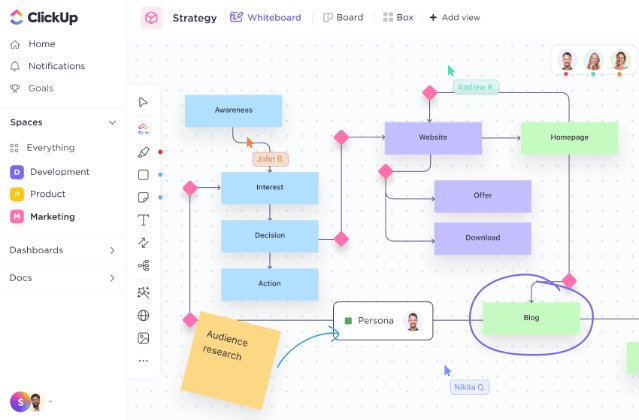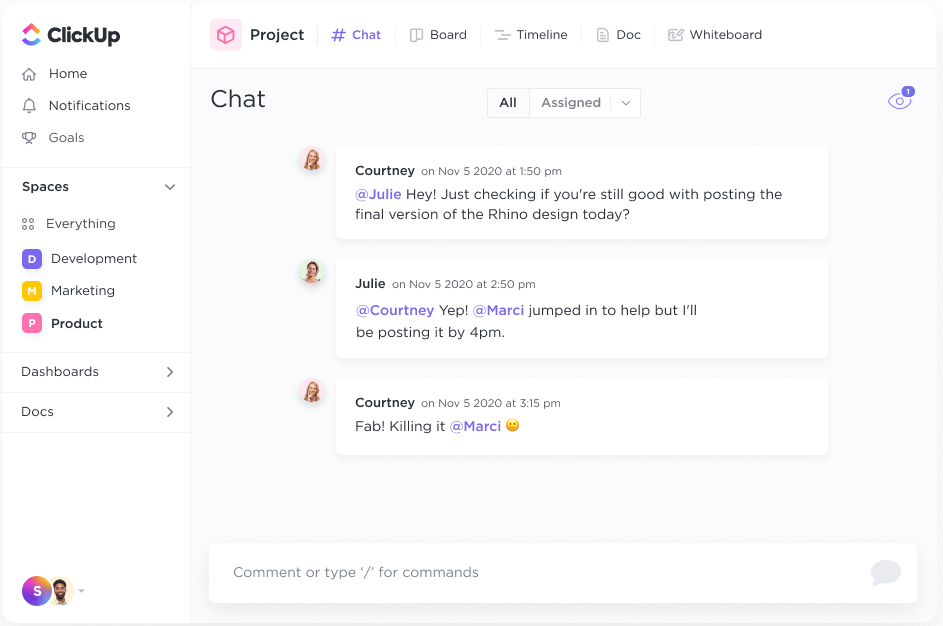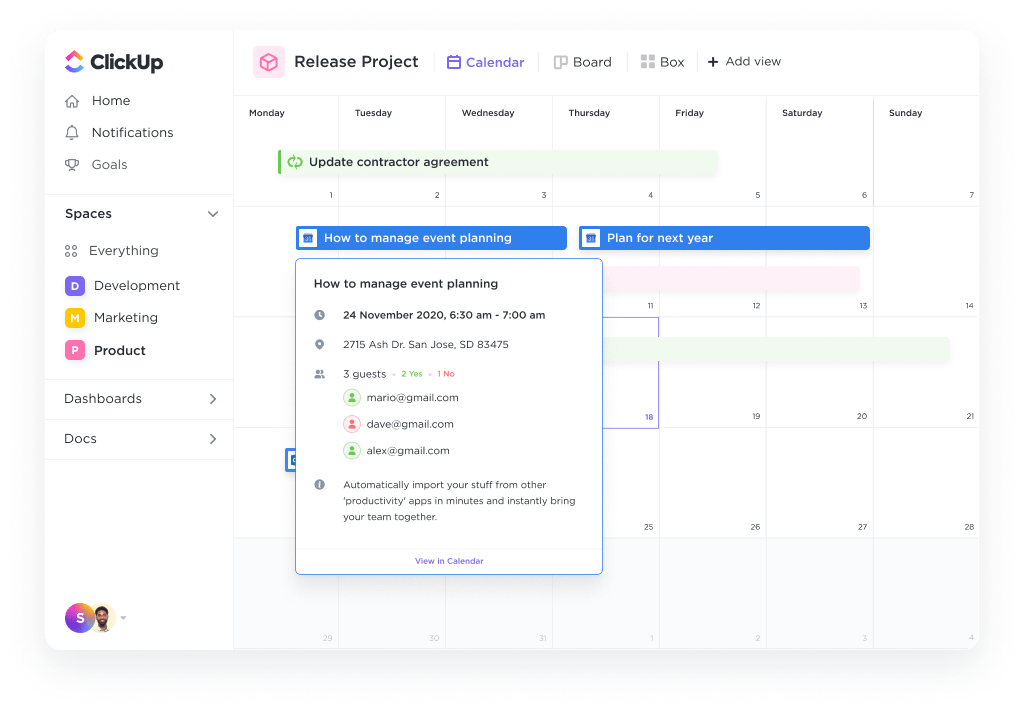في عالم الأعمال الديناميكي اليوم، يؤدي التعاون الجماعي دورًا أساسيًا في ضمان النجاح. فهو يغذي الابتكار، ويعزز التنوع في حل المشاكل، ويشجع على تبادل المعرفة والمهارات.
نحن في ClickUp، نؤمن أن العمل الجماعي لا يقتصر فقط على العمل معًا هو استخدام نقاط القوة المختلفة لكل عضو في الفريق لتحقيق الأهداف المشتركة. في هذه المدونة، سوف نتعمق في هذه المدونة في الفروق الدقيقة في تعاون الفريق، ونستكشف تأثيره على الإنتاجية ونقدم رؤى لتحسين جهودك التعاونية.
سواء كنت شركة ناشئة أو مؤسسة قائمة، فإن فهم أهمية فرق العمل التعاونية يمكن أن يمنحك ميزة تنافسية على منافسيك.
لنبدأ!
ما هو التعاون الجماعي؟
يحدث التعاون الجماعي الناجح عندما تعمل فرق مكونة من شخصين أو أكثر معًا لتحقيق هدف مشترك. تتطلب هذه العملية مستوى عالٍ من التواصل والثقة والاحترام بين كل عضو من أعضاء الفريق. وعندما يتم ذلك بشكل صحيح، فإنه يؤدي إلى بعض النتائج المذهلة.
فوائد تعاون الفريق الفعال
وجدت دراسة استقصائية أجرتها جامعة كوينز 75% من الموظفين يعتقدون أن التعاون ضروري في مكان العمل. ولكن حوالي 39% فقط من الموظفين يعتقدون أن شركتهم ليست متعاونة بما فيه الكفاية.

عبر جامعة كوينز في شارلوت
عندما يعمل الأشخاص معًا، فإنهم يتشاركون الأفكار ويتوصلون إلى حلول بشكل أسرع. وهذا يفسح المجال للفرق لحل المشاكل بطريقة إبداعية وإنتاج عمل أعلى جودة.
يساعد تعاون الفريق الناجح أيضًا أعضاء فريقك على الشعور بمزيد من المشاركة والاستثمار في عملهم. إذا سبق لك أن كنت جزءًا من فريق، فأنت تعلم أنه من الأسهل أن تكون متحمسًا وتركز على هدف مشترك.
وتشمل الفوائد الأكثر تأثيرًا التي ستراها من تعاون الفريق الفعال ما يلي:
زيادة الإنتاجية
لا تحتاج إلى تفكير، أليس كذلك؟ ومع ذلك، فإن الأمر يستحق التكرار. عندما يكون أعضاء الفريق قادرين على التعاون مع عدد أقل من الحواجز في الطريق، فإنهم ينجزون المزيد من العمل في وقت أقل. وهذا يؤدي في نهاية المطاف إلى ارتفاع مستويات الإنتاجية للفريق بأكمله.
تحسين التواصل
يضمن تعاون الفريق أن يكون جميع المشاركين على نفس الصفحة. يتم التعامل مع أي سوء توافق في المشروع بسرعة، وتقل حالات سوء الفهم التي تؤدي إلى إبطاء النتائج.
مرونة إضافية الأدوات التعاونية والبرمجيات يمكن أن تمنح أعضاء الفريق القدرة على العمل من أي مكان وفي أي وقت - مما يؤدي إلى جدول زمني أكثر مرونة لأعضاء الفريق من أجل
التعاون بشكل غير متزامن أو في الوقت الفعلي. تحقق من هذه الأدوات غير المتزامنة !
تحسين عملية اتخاذ القرار
من منا لا يحب اتخاذ قرارات أفضل؟
عندما يتعاون أعضاء الفريق بفعالية أكبر، فإنهم يقومون بمواءمة وجهات النظر والمهارات والبيانات المختلفة لاتخاذ قرارات أفضل تؤدي إلى نتائج أفضل.
قائمة الفوائد التي تأتي من
تعاون الفريق الحقيقي
طويل. ومع ذلك، فإن أحد الجوانب المهمة لضمان تعاون الفريق هو تزويد كل عضو من أعضاء الفريق بالأدوات المناسبة لتحقيق النجاح.

أنواع تعاون الفريق
- /مرجع/ /مدونة؟ ص=53047 التعاون غير المتزامن /%href/ : هذا النوع من التعاون الجماعي هو الذي يعمل فيه الأعضاء على مهام مختلفة ويتواصلون في أوقات مختلفة، إما عبر البريد الإلكتروني أو أنظمة الدردشة أو منصات المراسلة الأخرى. يمكن أن يساعد التعاون غير المتزامن في تحقيق النتائج بشكل أكثر كفاءة مع السماح بمرونة أفضل للتكيف مع جداول العمل المختلفة.
- التعاون غير المتزامن: التعاون المتزامن هو عندما يعمل أعضاء الفريق معًا في الوقت الفعلي ويتواصلون افتراضيًا بشكل مباشر. ويتطلب ذلك أن يكون الجميع متصلين بالإنترنت في نفس الوقت لمناقشة الموضوعات أو مشاركة الأفكار أو إكمال المشروع. يسمح هذا النوع من التعاون باتخاذ قرارات أكثر كفاءة ويمكن أن يساعد أيضاً في بناء العلاقات بين أعضاء الفريق.
- التعاون متعدد الوظائف: يتضمن التعاون متعدد الوظائف وجود أعضاء الفريق من مختلف مجالات المؤسسة يعملون معًا لتحقيق هدف ما. يسمح هذا النوع من التعاون باستخدام وجهات نظر ومهارات مختلفة، مما قد يؤدي إلى حلول أكثر ابتكارًا وإبداعًا.
- التعاون الموازي: التعاون الموازي هو عندما يعمل فريقان أو أكثر على مهام مترابطة ولكنها تتطلب مجموعات مهارات مختلفة أو لها أهداف مختلفة. يمكن أن يساعد هذا النوع من التعاون في تقسيم عبء العمل وجعل المهمة أكثر قابلية للإدارة بالنسبة للفرق لإكمالها.
- التعاون الهجين: يجمع التعاون الهجين بين عناصر من التعاون غير المتزامن والتعاون المتزامن، مما يسمح للفرق بالعمل معًا في الوقت الفعلي مع منح الأعضاء حرية إدارة جداولهم الخاصة. إنه نهج فعال عندما تحتاج الفرق إلى التعاون في المهام ولكنها تحتاج أيضًا إلى أن تكون مرنة في الوقت المناسب.
- التعاون دون اتصال بالإنترنت: التعاون غير المتصل بالإنترنت هو عندما تعمل الفرق معًا دون استخدام التكنولوجيا، وبدلاً من ذلك تعتمد على الاجتماعات وورش العمل الفعلية لتطوير الأفكار وإيجاد الحلول. يمكن أن يساعد هذا النوع من التعاون في خلق تجربة جماعية للفريق مع تعزيز العلاقات القوية بين الأعضاء.
10 استراتيجيات تعاون الفريق
1. استخدام برنامج تعاون الفريق
ستحتاج إلى برنامج أداة تعاون الفريق للارتقاء بالمستوى حقًا. ولحسن الحظ، فإن ClickUp هي الأداة المناسبة للقيام بذلك. تحقق من هذه الموارد والميزات من أجل إدارة فريق العمل الخاص بك .
للبدء، راجع هذا الدليل المفيد البرنامج التعليمي للبدء الذي سيوضح كل ما تحتاج إلى معرفته عن ClickUp.
إليك ملخص سريع لميزات التعاون الرئيسية في ClickUp:
- التسلسل الهرمي : طريقة إنشائك للمساحات والمجلدات والقوائم هي الخطوة الأولى لتعزيز التعاون بين أعضاء الفريق
- المشاريع والقوائم : تفتقر المنصات الأخرى إلى التنظيم المطلوب للعمل الرائع. بالتأكيد، يمكنك البدء في مكان جيد، ولكن مع زيادة مهامك، تخرج الأمور عن السيطرة. تمنحك المشاريع والقوائم مزيدًا من المرونة والتحكم في كيفية إنجاز عملك
- قوائم المراجعة والقوالب : لا تفوّت أي خطوة من المهام، وأنجزها واحدة تلو الأخرى. يعمل هذا بشكل جيد مع المهام ذات الخطوات المتعددة التي يجب أن يقوم بها أشخاص مختلفون في فريقك. يمكنك أيضًا حفظ قوائم المراجعة كقوالب لاستخدامها مرارًا وتكرارًا
- مكلفون متعددون
: التعاون يعني العمل معًا! وأحياناً يتطلب الأمر أكثر من شخص واحد لإنهاء مهمة ما. باستخدام ClickUp، يمكنك دائمًا تعيين مهمة لأكثر من شخص واحد، وحتىتعيين التعليقات
- النقر فوق المفكرة : قم بتدوين التذكيرات وعناصر العمل التي تريد مشاركتها مع الآخرين لاحقًا
2. بناء فرق متعددة الوظائف
تقليديًا، تتبع معظم الفرق نهج خط التجميع، حيث يساهم كل عامل في المهام الموكلة إليه في خط الإنتاج.
ولكن هناك طريقة أخرى: دمج أعضاء الفريق بمهارات ومواهب واهتمامات مختلفة حتى يتمكنوا من العمل معًا لإنشاء منتج بشكل أسرع.
جمال الفرق متعددة الوظائف هو أن بإمكانهم معالجة مشكلة معينة بمزيد من الكفاءة وبخطوات أقل فيما بينها. أضف الأتمتة إلى المزيج وميزات مثل تتبع الهدف في ClickUp وستنطلق في السباق.
3. التركيز على كفاءة الفريق
ما الذي يجعل الفريق فعالاً في الواقع؟ سواء كنت تعتقد أن الأمر كله يتعلق بالثقافة أو وضع أهداف أفضل، إليك بعض الطرق السريعة لتحسين فعالية فريقك:
- أرسل ملاحظة تشجيعية إذا كان هناك شيء لا يسير حسب الخطة
- أشر إلى ما يسير بشكل جيد بدلاً من الإشارة إلى إخفاقات الفريق فقط
- حدد موعداً لـجلسة عصف ذهني لتلك المشكلة المزعجة
- استخدمأداة إدارة المشروع
- متابعة التغذية الراجعة من قادة فريقك
- وضع أهداف شخصية وأهداف عمل واضحة
4. عقد اجتماعات مركزة
لقد جلسنا جميعًا في اجتماعات لا يبدو أنها تستحق العناء دون أن يكون لها نهاية في الأفق. في الواقع، قد لا تعرف حتى الهدف من الاجتماع في المقام الأول.
يحدث هذا في كثير من الأحيان أكثر مما يرغب معظمنا، مما يؤدي إلى تآكل معنويات الفريق ومستويات الطاقة. باختصار: لا تستنزف طاقة فريقك بالثرثرة التي لا طائل من ورائها. حسّن اجتماعاتك.
مصادر ذات صلة:
- 12 نصيحة حول كيفية التخطيط لاجتماع
- إدارة اجتماعاتك باستخدام ClickUp
- كيفية استخدام ClickUp لجداول الأعمال
- كيفية إجراء اجتماعات استهلالية رائعةhref/
5. تحديد أولويات إلهام الفريق
على الرغم من أن فريقك قد يكون متحمسًا لشطب المهام من قائمته والاستفادة من ملاحظات مديريه في يوم ما، إلا أنه قد يأتي إلى العمل دون أي إلهام في اليوم التالي.
ما الذي يمكنك فعله؟ فكر في استخدام التلعيب كوسيلة لتحفيز أعضاء الفريق. على سبيل المثال، منح الجوائز نقاط كارما لأعضاء الفريق التي يمكنهم تجميعها واستبدالها بجوائز قيمة.
إذا كنت تريد أن تأخذ الأمور إلى أبعد من ذلك، فابحث عن طرق مبتكرة لتشجيع الراحة لتقليل الإرهاق. سيشكرك فريقك وسيكونون مجهزين بشكل أفضل للتعاون على المدى الطويل.
6. ضع معايير للفريق من أجل أداء أفضل للفريق
ما هي المعايير التي يحتاجها فريقك لخلق ثقافة تعاونية أفضل؟
ما هي قواعد المشاركة التي يجب أن تستخدمها قيادتك مع موظفيك؟ قواعد الفريق هي فقط المجموعة الأولى من معايير اللياقة في مكان العمل .
إنه يزيل التخمينات من عملية تحريك المشاريع بين كل عضو من أعضاء الفريق عندما لا تسير الأمور كما هو متوقع.
7. استخدم المزيج الصحيح من أدوات تعاون الفريق
لا يفوتك الكثير من الأدوات البرمجية المذهلة المصممة خصيصاً من أجل جعل العمل أسرع وأسهل. للبدء، هذا أدوات التعاون ستساعدك القائمة. إنها مليئة بكل ما قد يحتاجه الفريق التعاوني. حتى لو كان فريقك متقدماً بالفعل، فأنت حتماً ستجد ما يساعدك.
هل تريد المزيد؟ راجع هذه الأدوات الرقمية والتناظرية للحفاظ على تنظيمك
مكافأة:_% أفضل أفلام الرفيق للعمل الجماعي
8. إضافة قوالب قابلة لإعادة الاستخدام إلى سير عملك
إذا كنت تطلب من فريقك القيام بمهام متشابهة كل يوم أو كل أسبوع أو كل شهر، فقد حان الوقت لتخزين التفاصيل والمعلومات وقوائم المراجعة في قالب قابل لإعادة الاستخدام . لحسن الحظ، هناك قالب ClickUp لكل نوع من حالات الاستخدام!
ارتقِ بقوالبك خطوة إلى الأمام واربط مهامك بتواريخ استحقاق متكررة وستحصل على تذكير أيضًا. القوالب، القوالب توفير الوقت وتجنيب فريقك العمل المزدحم الذي لا مفر منه والذي يأتي مع التعاون.
9. حسِّن تواصل فريقك
ليس يومًا سيئًا أبدًا أن تكون مستعدًا بطرق التواصل مع فريقك بشكل أكثر فعالية.
بدون تنفيذ أفضل استراتيجيات التواصل فإنك لا بد أن تتعامل مع المشاكل التي تنزف إلى مجالات العمل الأخرى:
- الفشل في الوفاء بالمواعيد النهائية
- إسقاط الكرة في المهام
- طلب وقت إضافي
- طلب إجازة
ضع في اعتبارك أن تكون مواظباً على الاجتماع مع فريقك بشكل مشترك وكذلك بشكل فردي. إنها طريقة للبقاء على اطلاع على ما يحدث من منظور فردي وجماعي.
10. كسر أكبر صوامعك
تمثل الصوامع أكبر عقبة أمام الفريق التعاوني.
ما لم تكن ترغب في تشجيع اتخاذ القرارات الضعيفة، وتقليل رؤية المشروع، وجعل العمل أكثر إيلامًا مما يجب أن يكون، فإن القيام بعمل كسر صوامع تعاون الفريق أمر بالغ الأهمية لفريق منتج بشكل مستدام.
إليك ما يمكنك القيام به:
- ضع أهدافًا مشتركة واجعلها واضحة جدًا لكل عضو في فريقك
- وضع نماذج للعمليات والأنظمة التي يتم استخدامها باستمرار
- تعزيز المساءلة عبر الفريق حول مشاركة التقدم والبيانات
- وحّد جميع بيانات مشروعك وتاريخ المشروع في منصة واحدة يسهل الوصول إليها
- شجع الرؤية باستخدام الأدوات الموجهة للمجموعة
أدوات تعاون الفريق
الخطوة الأولى لإنشاء بيئة عمل تعاونية؟ تأكد من وجود أدوات التعاون المناسبة في مكانها الصحيح.
إليك بعض الأدوات التي لا بد من امتلاكها:
/href/ /مدونة؟ ص=70053 أداة إدارة المشاريع التعاونية /%/href/
: A أداة إدارة المشروع مثل انقر فوق يساعد فريقك على تتبع المهام والمواعيد النهائية والتقدم المحرز مع تجميع كل ما يحتاجون إليه للمضي قدماً في المشروع.

أداة دردشة الفريق: أدوات الدردشة مثل Slack ضرورية لإبقاء أعضاء الفريق على اتصال فردي وتسهيل التواصل. على الرغم من أنه يمكن لقائد الفريق أيضًا استخدام ميزات الدردشة المدمجة التي توفرها العديد من الأدوات مثل ClickUp.
أداة مشاركة الملفات: أداة مشاركة الملفات مثل Google Drive تمكّن فريقك بأكمله من مشاركة المستندات والصور والملفات الأخرى الرئيسية بسرعة وسهولة. لهذا السبب ClickUp Docs هي ميزة رائعة لتركيز المستندات، وتعيين المهام لتلك المستندات، ومشاركتها بسهولة مع أعضاء فريقك.
أداة مؤتمرات الفيديو: أداة مؤتمرات الفيديو مثل تكبير تمكين فريقك من البقاء على اتصال حتى عندما يعملون عن بُعد وفي مناطق زمنية مختلفة.
السبورة الرقمية: السبورة البيضاء ClickUp يزود الفرق بجميع أدوات التعاون المرئي التي يستخدمونها لتبادل الأفكار وتنقيح المشاريع والتوصل إلى أفضل الأفكار.

أنشئ اللوحة المثالية لأفكار الفريق وسير العمل مع لوحات ClickUp Whiteboards
التعاون الجماعي في الموقع مقابل التعاون الجماعي عن بُعد
تعاون الفريق في الموقع
يحدث التعاون في الموقع بشكل مختلف عن التعاون عن بُعد على الرغم من أن الهدف النهائي لا يزال هو نفسه. ضع في اعتبارك بعض النصائح التي ستساعدك على رفع مستوى جلسات التعاون في الموقع.
إزالة العوائق
إذا كان تعاون الفريق المذهل هو الهدف، فلن تتمكن من تحقيق ذلك دون أن تأخذ الوقت الكافي أولاً لإزالة أي حواجز قد تقف في طريقك. هذا يعني أنك بحاجة إلى تزويد فريقك بأفضل برامج التعاون الجماعي حتى يتمكنوا من التواصل والتحرير وطرح الأسئلة وتسجيل الأفكار.
على سبيل المثال، تتضمن الميزات التي تزيل العوائق في أداة تعاونية مثل ClickUp ما يلي:
- أدوات مدمجة لإنشاء المستندات لتخطيط العمليات والجداول الزمنية
- تذكيرات آلية لضمان تواصل الفرق في الموعد المحدد
- ميزات تتبّع الوقت للحصول على نظرة عامة عالية المستوى حول مكان قضاء وقت فريقك
- أدوات إنشاء نماذج مخصصة لاستيعاب الأفكار وتنظيمها

إنشاء مخصص نماذج في ClickUp لالتقاط الملاحظات وتحويل الردود على الاستبيان إلى مهام قابلة للتنفيذ
إنشاء ثقافة تعاونية
إن تعزيز بيئة يشعر فيها الأشخاص بالراحة في العمل معًا ومشاركة الأفكار يتطلب تهيئة الأجواء المناسبة. وتتمثل إحدى طرق القيام بذلك في عقد اجتماعات منتظمة للفريق حيث يتم تشجيع الجميع على المشاركة من قبل من يشغلون مناصب قيادية.
يمكنك أيضًا إنشاء قناة دردشة للفريق حيث يمكن للأشخاص طرح الأسئلة ومشاركة الأفكار بحرية في وقتهم الخاص.
مكافأة:_
_/مرجع/ مدونة؟ ص=72589_ أنشطة بناء الفريق *%/href/_
!
تعزيز التواصل المفتوح
يتمثل ذلك في تهيئة بيئة يشعر فيها الناس بالراحة في التعبير عن آرائهم وأفكارهم وتفنيدها وشكوكهم حول أي شيء يحتاج إلى مناقشة.
تساعد كل من الدردشات والمستندات وتعيين الأدوار والمهام وسجل الترميز والنماذج على تمكين عملية التواصل المستمر .

تبسيط تواصل الفريق مع قنوات الدردشة في الوقت الفعلي في ClickUp
تعاون الفريق عن بُعد
كان التعاون في الموقع هو الطريقة التقليدية لدفع المشاريع إلى الأمام واتخاذ قرارات أفضل. ولكن الآن العمل عن بُعد هو القاعدة الجديدة للعديد من الفرق اليوم.
لهذا السبب من المهم العثور على موظفين موثوقين لفرق العمل عن بُعد للتواصل بنفس الفعالية كما لو كانوا في المكتب يتبادلون الأفكار وجهاً لوجه.
إليك كيفية تشجيع أعضاء الفريق على التعاون بشكل منتج.
اجعل كل عضو من أعضاء الفريق على اطلاع دائم
عندما يكون الجميع على دراية بـ أهداف الفريق فمن المرجح أن يحافظوا على توافقهم ويحققوا أهدافهم في الموعد المحدد. تأكد من أن الجميع على نفس الصفحة من خلال عقد اجتماعات منتظمة للفريق (افتراضيًا بالطبع) وإبقاء التواصل مفتوحًا.
تعزيز الشفافية
شجّع الشفافية من خلال إنشاء "مبرد مياه" افتراضي حيث يمكن لأعضاء الفريق الدردشة بشكل غير رسمي. أو قم بإجراء عمليات تسجيل وصول منتظمة حيث يمكن للجميع مشاركة ما يعملون عليه من خلال الدردشة المباشرة عبر تطبيق Zoom. الإيقاع مهم هنا. على الرغم من أنك لست مضطرًا إلى إغراق فريقك بالكثير من اجتماعات Zoom، يمكنك جدولة اجتماع متكرر كل بضعة أسابيع حيث يمكن للفرق مشاركة الملاحظات بشكل بنّاء.

مزامنة تقويم Google الخاص بك مع ClickUp
مركزي، مركزي، مركزي، مركزي
موارد الفريق المنعزلة هي الأسوأ. حيث تضيع المعلومات في الفوضى ولا يمكن العثور على أي مكان يمكن العثور عليه. ولكن هناك عدد من الأدوات الرائعة مثل ClickUp التي تساعد فرق العمل عن بُعد على البقاء على اتصال وتركز الأدوات والموارد التي تحتاجها فرق العمل عن بُعد لتنفيذ المشاريع.
تشجيع التفاعل الاجتماعي
فقط لأن فريقك يعمل عن بُعد لا يعني أنه لا يمكنهم التواصل مع بعضهم البعض. في الواقع، يمكن أن يكون التفاعل الاجتماعي طريقة رائعة لتشجيع التعاون.
يمكنك عقد ساعات سعيدة افتراضية أو استراحات لتناول القهوة، أو إنشاء نادٍ افتراضي للكتب حيث يمكن لأعضاء الفريق مناقشة ما يقرؤونه.
الاحتفال بالنجاحات بشكل مشترك
عندما يحقق فريقك هدفاً ما، احرص على الاحتفال معاً. سيساعد ذلك أعضاء الفريق على الشعور بأنهم جزء من وحدة متماسكة، وسيشجعهم على العمل معاً لتحقيق النجاح في المستقبل.
تعرف على المزيد من الطرق_
_/مرجع/ مدونة؟ ص=3115_ بناء العمل الجماعي الفعال *%/href/_
!
ClickUp: أفضل أداة للفرق التعاونية
من قال أن التعاون الجماعي الناجح صعب، ربما لم يقرأ هذا الدليل. أمزح، في الغالب. ولكن الحكم هو في: التعاون الجماعي ممكن ويمكن أن يكون مثمراً. بل وأكثر من ذلك عندما تكون لديك الأدوات المناسبة.
ارتقِ باستراتيجية تعاون فريقك من مبتدئ إلى خبير على مستوى عالمي مع ClickUp!
اشترك في ClickUp

